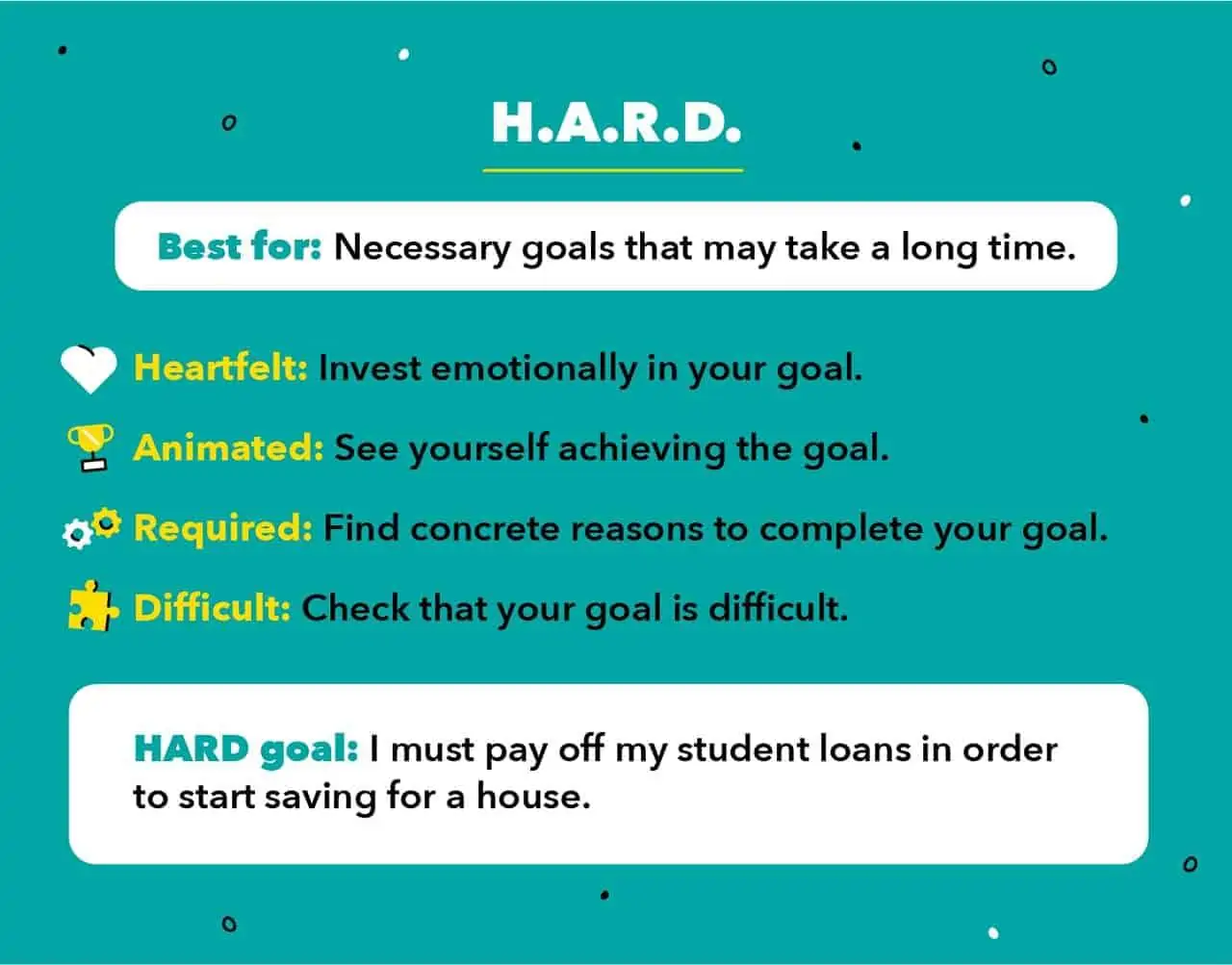Today's Thursday • 13 mins read
— Researched and written by Dr. Sandip Roy.
Whatever else we might be terrible at, we are great at setting goals. The problem is that we make them orphans before they become self-sufficient.
Why do we desert our well-meaning goals? Science has the answer.
Four common obstacles to goal realization, according to research by Gollwitzer & Sheeran, 2006, are:
- Failing to get started
- Getting derailed on the way
- Not stopping when things don’t work
- Overextending oneself and depleting willpower
These four obstacles start when we set poor goals, to begin with. But we could meet success more often if we only knew how to set effective goals.
So, let’s find out the best three methods of setting goals, including the modern WOOP.
Goal-setting is planning and taking steps to achieve any desired outcome. A well-set goal inspires us into action and gives us a definite direction to move.
Here are the three highly effective goal-setting techniques to propel you toward your desired targets:
- WOOP Technique
- SMART Technique
- HARD Technique
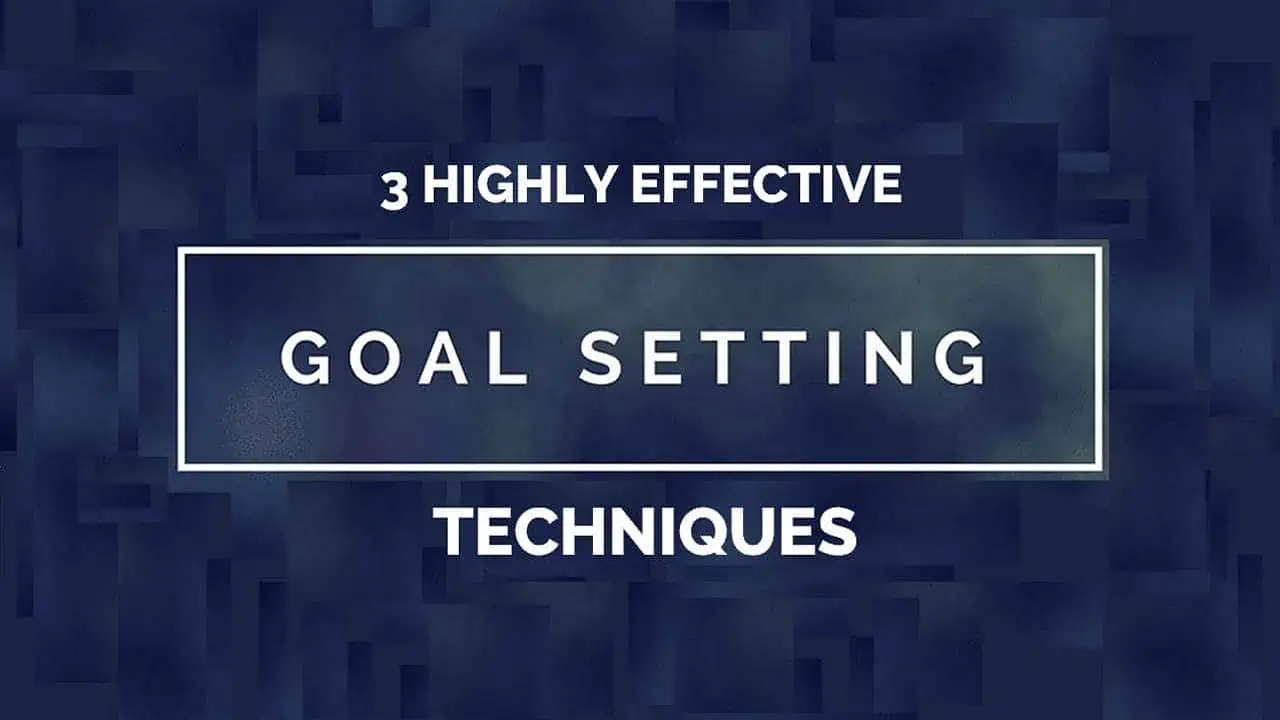
1. WOOP Technique
Highly efficient for setting both personal and business goals, this is the new modern technique based on solid science.
Gabriele Oettingen, author of Rethinking Positive Thinking: Inside the New Science of Motivation, and Peter Gollwitzer, psychologists at New York University, created WOOP after 20+ years of scientific research. It has proven effective across ages and life domains.
Dr. Oettingen is against the “Think Always Positive” and “Thoughts Become Things” movement. She’s clear that optimism can help us soften the immediate suffering and stand up strong during challenging times, merely dreaming about a bright future makes people more frustrated and unhappy.
The mere optimists turn out to be lazy and less likely to work for their goals.
In one of her studies, a group of women who envisioned themselves as already skinny, flaunting enviable figures in bikinis, appearing eye-catching, and effortlessly sidelining junk foods, lost 24 pounds (ca. 11 kg) less than those women who imagined themselves more negatively.
Positive visualizations don’t work. They make us falsely believe we have already achieved that bright future. As a result, we become unwilling to work hard toward our goals.
In her other research, WOOP improved effort, attendance, and even GPA (From Fantasy to Action: MCII Improves Academic Performance in Children) among students by significant margins. It reduced insecurity-based behaviors (e.g., looking through your partner’s phone log) and increased commitments in romantic relationships.
WOOP, an acronym for Wish, Outcome, Obstacle, Plan, utilizes the unique mental contrasting technique. It asks the participants to contrast a wish with an inner obstacle, and then develop an if-this, then-that (IFTT) plan.
- W — Wish – wish something you want to accomplish for real, one that is exciting, challenging, and realistic.
- O — Outcome – imagine the best outcome of your goal and recognize how it would make you feel.
- O — Obstacle – imagine the personal obstacles that prevent you from accomplishing your goal.
- P — Plan – make an if/then plan to name an action you could do if an obstacle appears.

WOOP bases itself on a visualization technique known as Mental Contrasting with Implementation Intentions (MCII) in the scientific literature.
- Mental contrasting: visualizing positive outcomes and also possible impediments.
- Implementation intentions: devising plans to take specific actions when obstacles appear on the path.
Studies show positive thinking alone does not help adults achieve their goals, but WOOP succeeds in the same. For example, WOOP doubled regular physical exercise over four months and increased fruit and vegetable intake by 30% over two years, while plain positive thinking failed.
Here is the 4-step process of achieving goals through WOOP (follow the steps in order):
- Step 1: Identify a goal you want to accomplish.
- Step 2: Visualize yourself achieving your goal.
- Step 3: Visualize the potential obstacles impeding you from achieving the goal.
- Step 4: Pre-plan meticulous solutions to each visualized obstacle that may appear.
There is also a WOOP app on Appstore and Playstore.
2. SMART Technique
Good for beginners, it is one of the most popular and efficient methods of goal-setting, especially for beginners. It says an effective goal should be SMART — Specific, Measurable, Attainable, Relevant, and Time-bound.
- Specific – you know exactly what your goal is.
- Measurable– you can measure and track your goal.
- Attainable – your goal is realistic, and you can achieve it.
- Relevant – your goal is exciting and meaningful to you.
- Time-bound – you have a clear deadline for your goal.
This method of setting goals originates from a management paper by George Doran. He was the former Director of Corporate Planning for Washington Water Power Company, Spokane. His paper identified how we could find out if our goals are worthwhile and purposeful [Doran, G. T. (1981). “There’s a S.M.A.R.T. Way to Write Management’s Goals and Objectives,” Management Review, 70, 35-36].
What Doran suggested back in 1981 quickly became a universal gold standard.
He proposed five criteria a goal should fulfill:
- Specific—target a specific area for improvement.
- Measurable—assess or at least suggest an indicator of progress.
- Assignable—specify who will do it.
- Realistic—state what results they can realistically achieve, given available resources.
- Time-related—specify when they can achieve the results.
It became famous when one of the most successful CEOs on this planet, Jack Welch, inducted this model in “General Electric” in the early 1980s.
However, there was a change Welch introduced into the SMART setup. He declared the goals should be Stretch goals instead of attainable goals.
Welch felt that attainable goals make one work from inside their comfort zone. While the Stretch goals lie at the outer limit of a person’s capacity, making them step outside their comfort zones.
Let us now talk about the Specific and Measurable parts of SMART.
- Specificity is the who, what, when, where, why, and how of the expectations from the goal.
- Measurability is the numerical dimensions of a goal so it can provide progress feedback and inform when the goal gets achieved.
Think of some common goals people make at the start of the year: lose weight, eat healthier, spend less, save more, exercise more, learn new things, spend more on charitable activities, make more real-world friends, and sleep more.
The thing that is wrong with those goals is that they are vague.
To make a goal worthwhile for your efforts, make them Specific and Measurable. The following are some good examples. Shedding 20 pounds of my weight by March.
Sticking to an intermittent fasting diet plan for the next 6 months. Saving 10 percent of what comes to me. Giving away 5 percent to charity. Exercising 20 minutes each morning. Going to sleep by 11 pm.
Next, we talk about the Attainable/Assignable and Relevant parts of SMART.
- A is for Assignable or Attainable
It means a goal must be Assignable to an individual or a group. When a goal is not assignable, we can hold no one responsible for achieving it, and thus the goal may never reach completion. Where it means Attainable, it means the goal should be within reach.
- R is for Relevance and/or Realistic.
Many goal-setters spend a good few years of their life pursuing a goal that does not give them any pleasure, even when achieved. As they sit there with their “trophy” at the end of the grueling race, they wonder where did it go all wrong.
It was this that went wrong: their goal was irrelevant or unrealistic or both.
When starting, they might have set that goal based on what others expected of them. Such a goal lay outside the boundaries of their personal values. Often, goals like that are irrelevant targets to aim at for personal growth.
Instead, they should have fixed a goal that was 1. Relevant to their overall idea of success in life, and 2. Realistic to their resources.
- T is for Time-bound.
A goal that is not Time-bound, and lacks a definite end, does not allow for feedback—as there is no definite date to work forward.
While setting a self-worthy goal, never buy into other people’s realities and aspirations. Aim for what you value and want.
Management experts later changed the SMART technique to include E. (Evaluate) and R. (Reassess) to make the model even more useful and productive. So, the SMART technique became an SMARTER one:
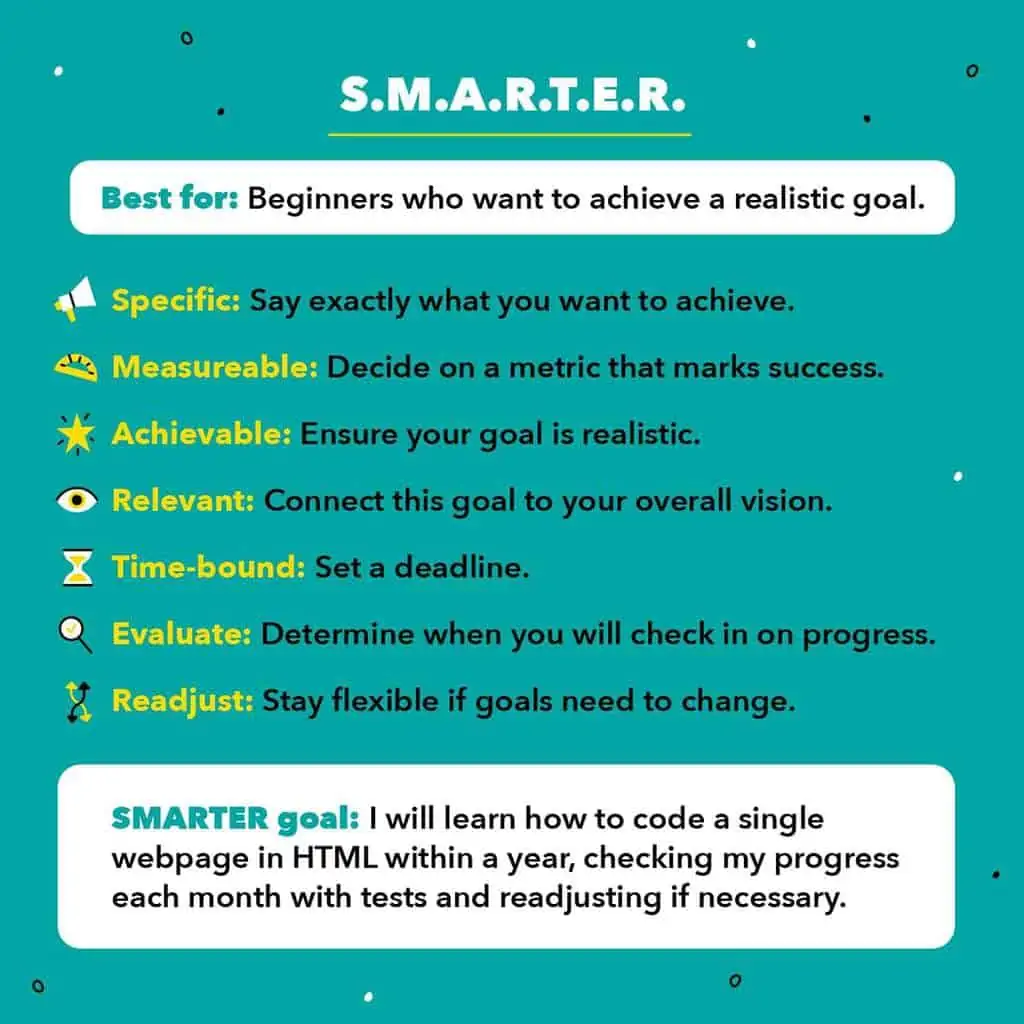
- S — Specific — should target a specific (clearly stated) area for improvement.
- M — Measurable — should have numbers or indicators to measure progress.
- A — Achievable — this should stretch you a little but stay within your skill/knowledge range.
- R — Realistic — should say what results can be achieved in realistic terms, with available resources.
- T — Timely — should specify when the results are due so that a sense of urgency is there.
- E — Evaluate — by evaluating your goals every single day, you’ll be much more likely to achieve them.
- R — Readjust — means to try various approaches until you find yourself getting closer to realizing your goals.
3. HARD Technique
Good for personal goals., it is an easy and effective way to follow when you want to set personal goals.
Mark Murphy ideated this second method in his well-researched 2009 book Hundred Percenters. To set productive goals, he says the proper way is: H.A.R.D.
Murphy’s research for his book revealed people who set HARD goals were up to 75 percent more fulfilled than those who set easy goals. He explains how success comes from knowing how to set HARD goals:
- Heartfelt – have an emotional attachment to your goals when setting them and try to make them “scratch an existential itch.”
- Animated – see yourself having achieved future success and imagine vivid pictures of the positive feelings after you have achieved them.
- Required – build a sense of urgency and necessity into the goals you are setting, and imbue your goals with a sense of immediacy and urgency.
- Difficult – make your goals difficult, and be prepared to take their challenges headlong, as outstanding achievements come from tough challenges that leave you feeling stronger, smarter, and happier.
2 Secrets of Setting Successful Goals
Let us quickly share the two best-kept secrets of goal-setting. Unknown to most, the two powerful ways (supported by science) to make your goals succeed are:
1. Set Your Own Goals
Set your goals. Do not let or make others set goals for you.
If others set a goal for you and you find it a stretch, then you might use unethical ways to achieve it. You could even lie about having achieved it. However, if it is you who is setting them, then you stay more committed to those goals. So do not let others set your goals.
2. Keep Your Goals Secret
After setting goals, write them somewhere but keep them secret. Do not reveal your goals to others.
If you broadcast your goals to anyone who would listen to praise you, you will end up sabotaging yourself. Because receiving compliments for being a guy having a lofty goal might fool your mind into feeling as if it has already achieved the goal. Doing this will take away your motivation to make efforts to realize your goals. So do not tell your goals to anyone.
Set your goals yourself; don’t let others do it for you. And once you set your goals, keep them to yourself; do not tell others.
3 Types of Goals
Goals can be of three types: process goals, performance goals, or outcome goals.
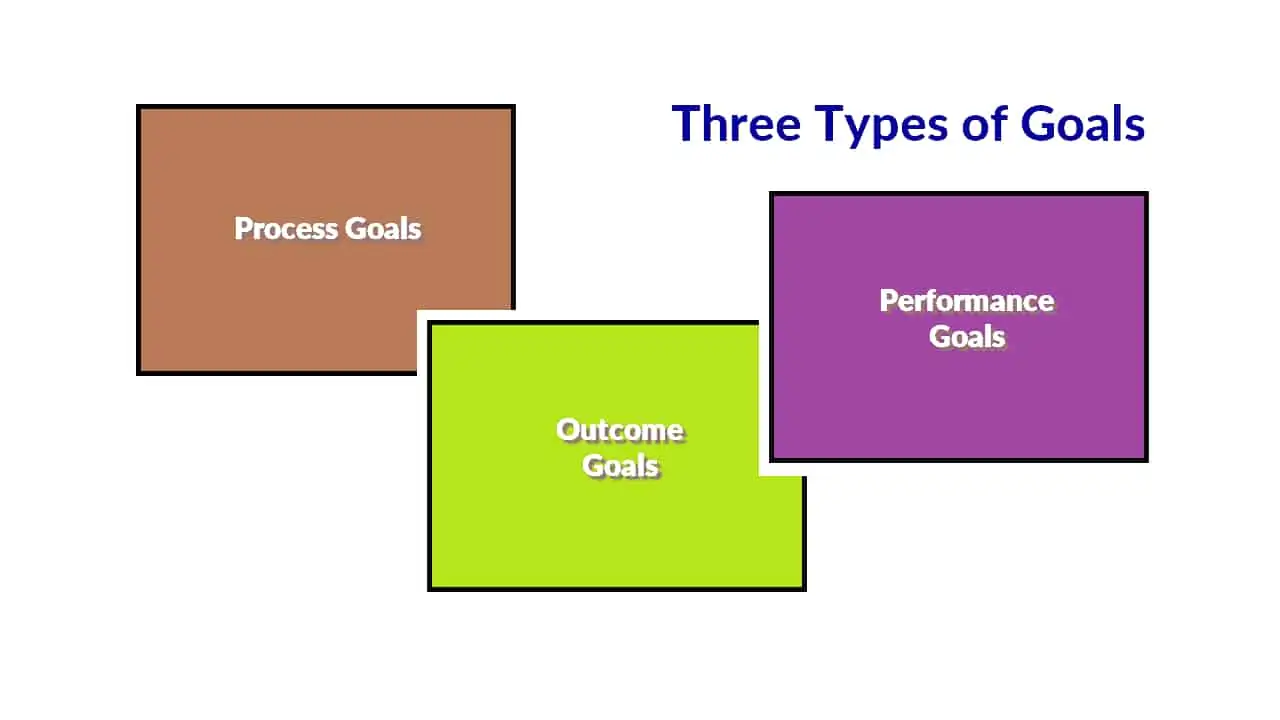
- A process goal is an expected result based on specific actions and tasks. It deals with the techniques to perform well and is a step toward a performance goal. A process goal is fully controllable at the individual level.
- A performance goal is an expected result based on a personal standard. It deals with the criteria a person sets for themselves and is a step towards an outcome goal. A personal goal is mostly controllable.
- An outcome goal is an expected result based on prevailing. It compares your results against those achieved by others. An outcome goal is not fully controllable at the individual levels and gets influenced by outside factors.

7 Reasons Why It’s Important To Set Goals
Goal-setting is the first step toward success. Without goals, successes remain undefined wishes. With the setting of goals, our wishes and aspirations take concrete shape.
Here are 7 reasons why goal-setting is important:
- The act of goal setting is the seed of motivation. The primary purpose of setting goals is to increase your motivation levels.
- With the goals you set, you take control of your life. When you set goals, instead of letting others pick choices for you, you take control and decide what you want for yourself.
- Goals are the first mission-centric creation in your mind. When you set goals, you have a clear mission to work on. As they say, you create everything twice: first in your mind, and then in the real world.
- Your goals decide what you want to do with your life. Goal-setting makes sure you are looking at and pushing yourself in the right direction. It makes it likely to get your desired results within a set time limit. You no longer wait for things to happen to you.
- Goals put you in a position where you can adjust your actions while on your way to success. When you set goals, plan, and think ahead. And even when they do not work out exactly as you planned them, they make you self-confident that you will succeed.
- Goals show you the best point to focus on for success. Your goals give you a laser focus on exactly what to spend your time and energy on.
- Having goals makes you feel responsible and accountable. You can then hold yourself to answers for doing things that do not align with your goals.
Goal-Setting Quotes
Aristotle, philosopher, and tutor to Alexander the Great, said some 2300 years ago:
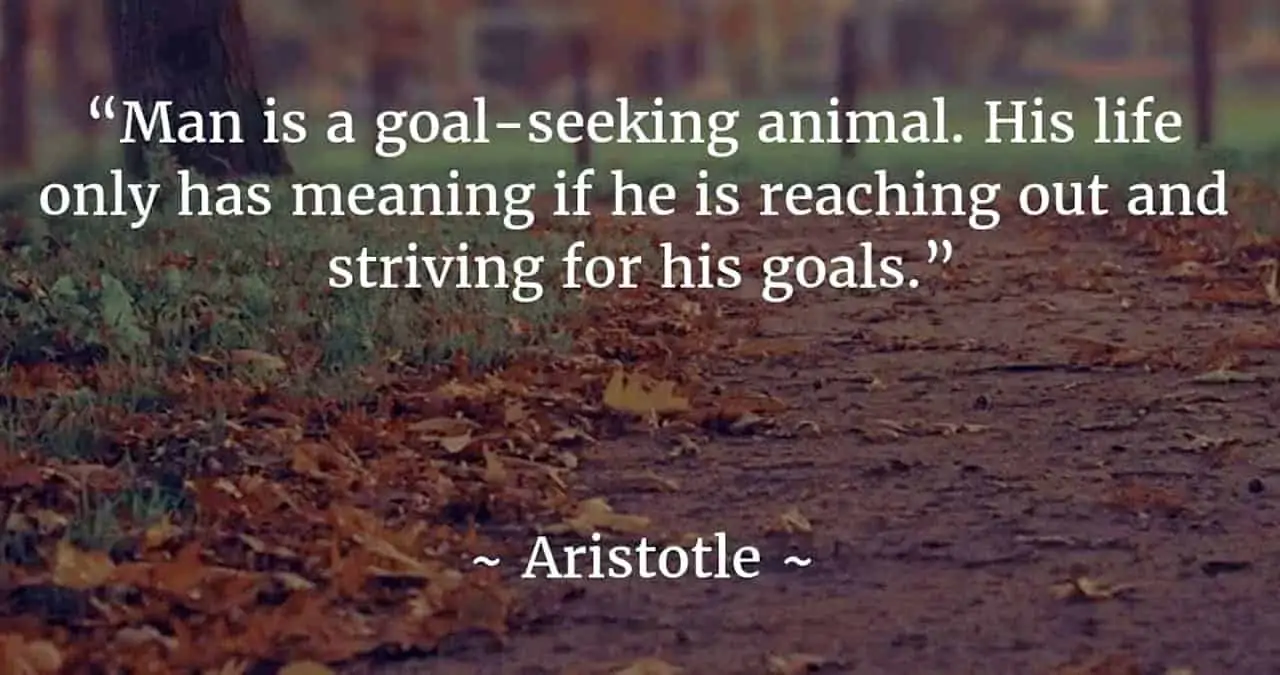
Man is a goal seeking animal. His life only has meaning if he is reaching out and striving for his goals.
In their book, based on more than 1,000 studies into business goals, Edwin Locke and Gary Latham, say:
There is strong evidence that the increase in job performance produced by goal-setting has important economic and practical value.
Remember the following words of Benjamin Mays, the minister who laid the intellectual foundations of the American civil rights movement:
The tragedy in life doesn’t lie in not reaching your goal. The tragedy lies in having no goal to reach.
Final Words
Download the PDF: 3 Goal-Setting Techniques (PDF)
At least a few thousand people from across the world start their year with this ambitious goal: “This year, I will finally write that book.” But, within weeks, that goal begins its trip to some faraway planet’s moon, with a promise to return the next year.
But now you know how to avoid setting goals bound to fail.
When you set a persuasive goal, you feel better about it immediately after. That in itself sets the dice rolling. And remember that happiness for most of us, most of the time, is not a thing that happens; it comes from planning and setting goals for things important to us.
[This article got featured on Mint’s blog: How To Set Goals And Achieve Them.]
√ Also Read: 7+3 Unusually Good Success Tips (No One Told You Before)
√ Please share this if you found it helpful.
